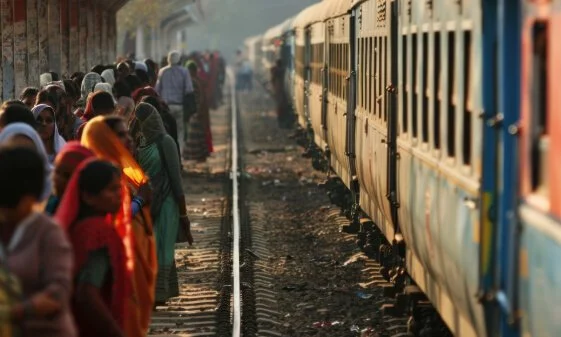More Indians Choosing Non-AC Travel, Raising Doubts About Real Economic Growth
Indian Railways Adds Non-AC Coaches as Demand for Low-Cost Travel Rises
July 29, 2025
The government points to macroeconomic indicators, such as rising GDP, higher tax collections and increased infrastructure investment, as signs that the Indian economy is growing. But growth at the national level does not always translate into better living standards for most citizens. A recent report on Indian Railways provides a useful lens to examine whether this growth is widely shared.
According to the report, out of Indian Railways’ total 82,200 coaches, around 57,200 – nearly 70% – are non-AC coaches, as reported by The Indian Express. These include general, sleeper and other low-cost compartments. AC coaches, which are more expensive and considered a proxy for middle-class and upper-middle-class travel, make up only about 30% of the total.
This distribution alone would not raise questions if it had been consistent over the years. But the figure of 70% non-AC coaches reflects a conscious decision by the Railways to expand these services in response to demand. That means more people are choosing non-AC travel, and the Railways are adding coaches to meet that demand.
The decision reflects a basic economic principle of demand responsiveness: producers (in this case, the Railways) supply more of what consumers are asking for. If more people were moving into higher income brackets, we would expect to see greater demand for AC travel, and the Railways would respond by increasing AC coaches. But the opposite has happened.
The fact that non-AC coaches are rising in number suggests that the majority of passengers are still price-sensitive and unable or unwilling to afford AC fares.
This leads to the question of income distribution, which is a key concern in economics. It’s possible for a country’s GDP to rise while most of its population sees little improvement in real income. GDP growth is an average, and like all averages, it can be misleading. If high-income individuals and large companies are earning significantly more, they can drive up the national average, even if incomes for the bottom 70% of the population remain stagnant or fall. Economists call this a “growth without inclusion” scenario.
The demand for non-AC travel also points to another economic concept: revealed preferences. Unlike surveys or statements, actual behaviour reveals what people can afford and choose. When a traveller books a general or sleeper class ticket instead of an AC one, they are revealing their economic constraints. If more people are making this choice, it suggests that the so-called economic growth is not expanding their disposable incomes in real terms.
Another angle is the concept of purchasing power parity, or what your money can actually buy. If wages are not keeping up with the cost of living, especially in cities and large towns, then even if people are earning nominally more, their real purchasing power may not be increasing. A growing preference for cheaper travel options could suggest that people are prioritising basic savings, or that they cannot stretch their budget for AC travel, which remains a discretionary expense.
Furthermore, in developing economies, upward mobility is often reflected in small, measurable lifestyle shifts: switching from public to private transport, renting larger homes or upgrading to AC train travel. If such trends are not being observed across a broad population, that suggests that economic mobility is either stalled or limited to a narrow segment of society.
Public transport usage patterns, especially long-distance ones like the Railways, are considered reliable indicators of economic well-being among lower- and middle-income groups. When over two-thirds of the railway infrastructure is still oriented toward low-cost travel, and this is due to ongoing demand, it’s a sign that economic pressure remains high for most Indians.
You have just read a News Briefing by Newsreel Asia, written to cut through the noise and present a single story for the day that matters to you. Certain briefings, based on media reports, seek to keep readers informed about events across India, others offer a perspective rooted in humanitarian concerns and some provide our own exclusive reporting. We encourage you to read the News Briefing each day. Our objective is to help you become not just an informed citizen, but an engaged and responsible one.

